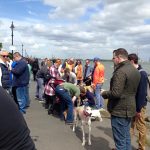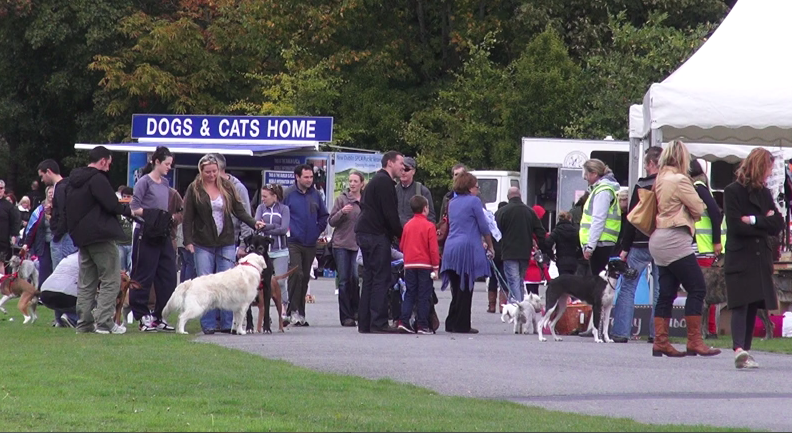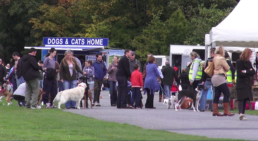How to take professional-looking pet portraits
We all like to photograph our pets and taking professional-looking portraits does not need to be as complicated as we think. Although it does take time and patience, it does not necessarily need a lot of expensive equipment.
Over the next few weeks, I'll be posting a series of lessons on how to photograph pets. Each one will look at a different aspect of pet photography. Here's an idea of what's to come:
Part 1: Photographic Equipment - selecting a camera; using auto and manual focus; lighting and accessories.
Part 2: Animal Behaviour - understanding animal behaviour; personal space/fear circle of pets; techniques to use and avoid during a photographic session.
Part 3: Natural Portraits - controlling natural light using fill-flash and reflectors.
Part 4: Studio Portraits - selecting suitable backgrounds; basic lighting set-ups; importance of eye contact.
Part 5: Action Portraits - photographing animals in motion; shutter speeds; background details.
Part 6: Digital Imaging Editing and Printing - basic image editing; printing your images.
I will also be posting some photographic exercises for you to try yourself.
The art of any form of portrait photography is to capture the character and personality of your subject. So you will need to encourage your pet to relax and behave naturally in front of the camera. Sessions should be kept short, because animals get bored quickly and once that happens you will have to put the camera away until another day. Also, as you cannot ask your pet to say 'cheese', you will have to resort to other ways and means to encourage them to 'smile' for the camera. But, above all, whatever approach you adopt when photographing your pet remember their safety and welfare must always come first.
The aim of this series is to give you, as a pet owner, the inspiration and knowledge to take stunning photographs of your pet, however inexperienced a photographer you are.
How to protect your dog from heat stroke
As the warm summer weather approaches, it's important to remember that dogs are vulnerable to heat related injuries, the most dangerous of which is heat stroke, which can often prove fatal.
Heat stoke and heat exhaustion are dangerous conditions for any dog and should be avoided at all costs. Heat stroke occurs when the dog's normal body mechanisms are unable to keep body temperature within a safe range. A dog's normal body temperature is 100-102.5 degrees. A body temperature over 106 degrees is deadly.
Heat Exhaustion
Heat exhaustion, the early stages of heat stroke, occurs when the dog begins overheating. To remedy the effects of heat exhaustion, you must take immediate action to reduce the dog's body temperate and prevent the danger of heat stroke. Symptoms of heat exhaustion include diarrhea, nausea and vomiting, rapid panting, and the skin inside the ears reddening. Should you notice any of these symptoms and suspect your dog might be suffering from heat exhaustion, take immediate action by bringing your dog indoors to a cooler environment immediately, near a fan if you have one, offer some fresh water, and dampen the dampen the skin with lukewarm water and allow it to air-dry.
Heat Stroke
Signs of heat stroke include rapid panting, a bright red tongue, red or pale gums, and thick, sticky saliva. The dog may also show signs of weakness, dizziness and vomiting.
If you suspect your dog is suffering from heat stroke, remove them from the hot enviroment immediately. Wet them thoroughly with room-temperature water (do not use not ice or very cold water, as it will trigger other life-threatening conditions), and increase the flow of cool air around them with a fan.
Five Ways to Prevent Heat Stoke
So, here are five things to remember when the temperature gets high in the summer months:
- Don’t let your dog linger on hot surfaces like asphalt and cement. Being so close to the ground can heat their body quickly and can also lead to burns on sensitive paw pads. Keep walks to a minimum.
- Provide access to fresh water at all times. Make sure an outside dog has access to shade and plenty of cool water.
- Restrict exercise when temperatures soar, and do not muzzle the dog because it inhibits their ability to pant.
- Many dogs enjoy a swim, splashing in a pool, or running through a sprinkler in warmer weather can help bring body temperatures down.
- Never leave your pet in a parked car, not even if you park in the shade or plan to be gone for only a few minutes. The temperature inside of a car can reach oven-like temperatures in just minutes, often in excess of 140 degrees. That quick errand to the shops can very quickly turn into a disaster and could be fatal for your pet.
The last point is particularly important to remember. The number of times I have seen a dog left alone in a parked car at the supermarket during the warmer summer months is horrifying. If you know you have to stop by the supermarket to pick up a few groceries, please leave your dog at home. Your dog will thank you for it!
Remember: Any dog that cannot cool itself off is at risk from heat stroke!
Hounds for Love: Yes Equality





Baxter insisted we came with him to today's Hounds for Love: Yes Equality bank holiday stroll in support of marriage equality at Sandymount Strand today.
A big thanks to the kind man who gave Baxter his bandana. And thanks to Seamus Dooley, who invited us along!
Meet the dog lover behind Dublin's Cheeky Dog Bakery

Recently at a DSPCA Doggie Day Out in St Enda's Park in Rathfarnham, Baxter and I came across a yummy new service just for dogs. Though we all know that cakes and sweets are not healthy for our dogs, it is great to see a new way of providing tasty treats for pooches.
Cheeky Dog Bakery began two years ago after dog lover Jenny McCarthy struggled to find a birthday cake to celebrate her dachshund Oscar's first birthday. Unable to find one, she decided to make her own. Much to Oscar's delight!
Inspired by her own attempt a baking a birthday cake for Oscar, she spent a year researching and testing recipes and acquiring all the necessary skills to set up her own dog bakery.
Jenny runs the successful Cheeky Dog Bakery online, selling everything from donuts to birthday cakes for dogs.
All her dog treats are hand made with dog friendly ingredients using only natural human grade organic ingredients, including carob, as dogs should never eat chocolate.


Jenny’s dog treats include a Birthday gift box, which contains a large two-tier cake cookie, a large Happy Birthday bone with paw and heart detail, two gift cookies with bow detail, 12 peanut butter Mini Bites and two delicious Puppermint Donuts in vanilla and carob - all for €20.
If you would like to order any cakes, have a special request or special doggy dietary requirements, Jenny can also tailor make special goodies with a little help from Oscar of course!
You can check out all her canine goodies at www.cheekydogbakery.com
Baxter at the DSPCA Doggy Day Out

Marlay Park today.
There were plenty of events to choose from, such as ‘Scrufts’ the all-inclusive dog competition, to a demonstration from Dog Sled Ireland, from Dog Training Sessions with ‘King of Paws’ Alex Pitrelli, to doggy speed dating; this canine carnival had something for everyone. But the best part was getting together for a group photo of all the dogs and their owners.
The Dublin SPCA is Ireland’s oldest animal welfare organisation and every year it rescues, re-homes and cares for thousands of dogs through its centre in Rathfarnham and its mobile veterinary clinics. The DSPCA relies on charitable donations to keep its service in operation.
To read more about the DSPCA, please click here.
Welcome to Petfriendly Ireland
"My Ma and Da spend all their time on their laptops, so I thought I'd get in on the act and set up my own blog.
I'm Baxter the border collie, I'm 4 years old, and I live in Dublin with Nessa & Peter. Before I met them, I lived with a whole lot of other pals in the DSPCA pound in Rathfarnham. That was great craic, but I missed my comforts and the long stretches up and down the mountains. So when Peter and Nessa invited me home, I decided to try them out.
Three years later, here I am on the internet! I'll be telling you about the sort of things I get up to, the fancy places I've stayed and the great walks I've found. But don't be surprised if Nessa and Peter put their paws in ... I have to fight them for a go on the keyboard!
See you later, Baxter."





